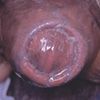- Clinical Technology
- Adult Immunization
- Hepatology
- Pediatric Immunization
- Screening
- Psychiatry
- Allergy
- Women's Health
- Cardiology
- Pediatrics
- Dermatology
- Endocrinology
- Pain Management
- Gastroenterology
- Infectious Disease
- Obesity Medicine
- Rheumatology
- Nephrology
- Neurology
- Pulmonology
Middle-Aged Man with Polyuria and Penile Swelling and Pain
For 2 weeks, a previously healthy 40-year-old man has had excessive thirst and increased frequency of urination. He awakens at least 5 times every night to urinate. He reports no nausea, vomiting, change in bowel habits, chest pain, or dyspnea.

THE CASE: For 2 weeks, a previously healthy 40-year-old man has had excessive thirst and increased frequency of urination. He awakens at least 5 times every night to urinate. He reports no nausea, vomiting, change in bowel habits, chest pain, or dyspnea.
On further questioning, the patient recalls that during the past 2 weeks he has also had penile swelling and pain, but no discharge or dysuria. He denies any history of sexually transmitted diseases and states that his wife is his only sex partner.
The patient has a swollen foreskin and an erythematous glans with whitish discharge. Cardiac, respiratory, and abdominal findings are unremarkable.
What do you suspect?
- Erythroplasia of Queyrat
- Phimosis/paraphimosis
- Balanoposthitis
(Answer and discussion on next page.)

Answer: Balanoposthitis
DISCUSSION: This patient has balanoposthitis, an inflammation of both the glans penis and the foreskin in uncircumcised men. Balanoposthitis often is the first sign of diabetes and is usually associated with polyuria.
Physical examination of the glans and prepuce may reveal a macular lesion with associated erythema. Attempts to retract the foreskin may result in purulence, excoriation, and erythema of the glans and apposing prepuce.
Candida is the causative organism in many cases of infectious origin; however, Bacteroides, Gardnerella, and b-hemolytic streptococci have also been identified in adults with balanoposthitis. Diagnostic evaluation may include potassium hydroxide (KOH) slide preparation and culture for Candida species.
The mainstay of treatment is prevention with proper hygiene. This consists of frequent washing, with mild soap, and drying of the prepuce. Topical antifungal agents (nystatin or clotrimazole) or antibiotics (metronidazole cream) also may be used. In recurrent or recalcitrant cases, circumcision may be required. A first- or second-generation cephalosporin may be prescribed when a bacterial infection is suspected (eg, when warmth and edema of the glans, penile shaft, or foreskin are present). If all treatment modalities fail or if malignancy is strongly suspected, referral to a dermatologist for biopsy and further evaluation is warranted.
Erythroplasia of Queyrat, or carcinoma in situ of the glans penis, was first described by Tarnovsky in 1891. Although rare, the disease is most common in uncircumcised men older than 40 years. The lesions may be single or multiple with well-demarcated margins, a red-velvety appearance, and a granular surface. Many causes have been implicated, including repetitive irritation from an infectious source (ie, herpes simplex virus or human papilloma virus) or from poor hygiene. Physical factors include chronic friction, heat, and trauma.
The diagnosis of carcinoma in situ is confirmed with skin biopsy of the affected area. However, it is important to rule out an infectious cause with bacterial, viral, and fungal cultures; KOH preparations; and Gram stain. Patients are treated with either antineoplastic agents or surgical intervention.
Phimosis is the inability to retract the foreskin posterior to the glans penis, whereas paraphimosis is the inability to reduce the foreskin over the glans. Most cases of phimosis/paraphimosis are congenital. Acquired phimosis/paraphimosis usually occurs in men who practice poor hygiene or who have had frequent catheterizations in which the foreskin was reduced.
Continued poor hygiene or chronic infections may lead to the formation of a fibrotic ring of tissue and ultimately phimosis. A fibrotic ring can cause obstruction of the urinary stream, hematuria, or preputial pain. Paraphimosis may develop if the fibrotic ring is retracted over the glans with inability to reduce the foreskin. Subsequent constriction by the fibrotic ring can lead to edema and venous engorgement and may compromise the arterial blood supply.
Paraphimosis is a urological emergency because necrosis of the glans from arterial occlusion can rapidly occur. The foreskin is reduced either manually or invasively via vertical incision of the dorsal aspect of the constricting preputial ring. Consider invasive reduction only after all noninvasive measures have been exhausted and with urological consultation.
References:
REFERENCES:
1.
English JC. Dermatoses of the glans penis and prepuce.
J Am Acad Dermatol.
1997;37:1-24.m Hartke DM, Palmer JS. Anomalies of the penis.
J Men's Health Gend.
2006;3:244-249.
2.
Waugh MA. Balanitis.
Dermatol Clin.
1998;16:757-762.
